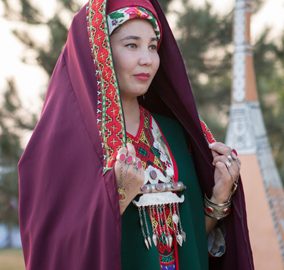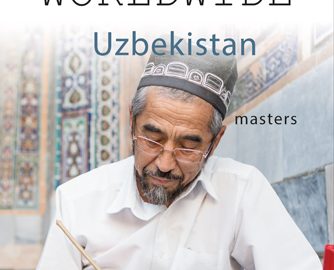Color and passion from all over the world – five days in Kokand
By Hester Dijkstra.
Uzbekistan, a country with a magnificent historic architecture, as well as a rich crafts tradition.
Invited by the embassy of Uzbekistan in Brussels, Diplomat Magazine had the opportunity to visit Uzbekistan’s 1st Handcrafters Festival in Kokand. As we quickly realized, it was there that the best objects and souvenirs could be found.

The majority of tourists generally do not come to Kokand, as they more often visit the capital Tashkent and the ancient cities of Samarkand, Bukhara and Khiva. These cities are known for their location along the Silk Route, which stretched from China to the Mediterranean.
Yet, Kokand is a truly beautiful place, where one can find mosques with turquoise domes, madrassahs (former Koranic schools) whose facades are beautifully decorated with geometric motifs, gold-clad mausoleums, and colorful, vibrant bazars. On top of that, in September the city has hosted a major ‘handcrafters festival’ – the first of its kind in the country.

Kokand
Kokand, which is located 228 km southeast of the capital Tashkent, is a historic city in the Fergana valley. The city, which lies along the itinerary of the old Silk Route, was destroyed several times, but in the 18thcentury it became once more a thriving city under the reign of Khudayar Khan, the last ruling Khan. During this period, the city became a political, cultural and religious center, hosting 35 madrassahs and 300 mosques. Although only a few of these are still there today, the old part of the city is worth a visit – especially the Khudayar Khan Palace, a real jewel.
The International Handcrafters Festival in Kokand
For the first time, a huge event such as the International Handcrafters Festival has been organized in Kokand. With craftsmen from 78 countries, as well as 1100 Uzbek craftsmen displaying their hand-made artworks, the Festival has been a great success – to the extent that the Uzbek government, a staunch supporter of the country’s art, has the intention to organize such even every two years.

In an impressive opening ceremony, the President of Uzbekistan Shavkat Mirziyoyev opened the festival. The President’s speech was followed by a mayor colorful spectacle of traditional Uzbek music and dance, and the memorable evening ended with fireworks.

The festival site, the 17-hectare ‘Urdoldi square’ in front of the spectacular Khudayar Khan Palace, was subdivided into areas named after Uzbek provinces, with each area featuring theater, music, dance, fashion, and acrobatics shows.

While being at the Festival, one would be suddenly surrounded by drumming musicians and dancing women, all wearing national costumes adorned with the most beautiful jewels. Uzbeks definitely know how to make you feel at home.
Throughout the Festival, craftsmen showed their artworks to the visitors with an incredible passion and love. These people really perform their craft with their heart and soul – and an attendee of the Festival can see their unique masterpieces one by one.

One of the most difficult things about the Festival is to choose what to buy among all the beautiful artworks exposed: ceramics, embroidered wall hangings (suzani’s), jewelry, musical instruments, silk cushions and shawls, pen drawings, woodwork furniture and bowls.
The accomplished ‘masters’ liked talking to us, and they would stand proud when asked whether we could take a picture. One becomes a master only after having acquired all the necessary knowledge, as well as having learnt various techniques of the profession.

The master then develops his own ‘handwriting’, which sets him or her apart from others. The Uzbek craft has been passed along for generations, thus maintaining the people’s knowledge of the craft still alive as of today.

“You are welcome in my house. Please, come and I will show you my place” – masters would often say. Many of them invited us to come to their homes and meet their families – something that, unfortunately, we often did not have the time for.
At the end of the festival, various prize winners were awarded, and the public enjoyed a concert by Uzbek pop stars.
Dutch paper makers

The Netherlands was represented at the Festival by two paper makers, Leo Hoegen and Marieke de Hoop, who displayed their craft on behalf of the Crafts Council of the Netherlands, the national umbrella body for contemporary creative craft.
Leo is a true artisan, and he knows everything about making paper. A bookbinder and printer, he creates his artworks from old paper, plant material and even textile. Marieke has her own center ‘Papierlab Rotterdam’ in the Netherlands, a place where all paper artists and paper makers can combine their knowledge and technology and show it to the world. Their aim is to use the old tradition and skills of papermaking in our modern times, and to develop these techniques even further.

In the Dutch booth, I showed my photo book to the public. The book – titled “Worldwide – Uzbekistan, masters”, is all about Uzbekistan’s crafts, and about the masters and students that I met during my vacation in Uzbekistan in 2018. Many of the beautiful things I saw in that period are displayed in the book.
Fergana valley
Tourists traveling through Uzbekistan should definitely not skip the Fergana valley, which is known as the greenest area in the country, and which is home to an abundance of delicious, sweet, fresh fruit. The valley is also known for its cotton cultivation, silk production, and azure earthenware. The razor-sharp knives and world-famous skull caps are made in the town of Chust.
It is very nice experience to visit the silk factories in Margilan and the potters in Rishton; and, of course, to attend the International Handcrafters Festival.

Thanks to the Embassy of Uzbekistan in Brussels for helping us find the best places and making this trip possible.
Photography by Hester Dijkstra.



